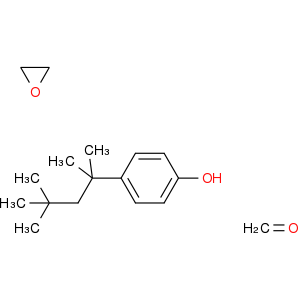您当前的位置:首页 > 前衍产品库 >
25301-02-4 四丁酚醇 >百科

生成产品海报
基本信息
CAS:25301-02-4
中文名称:四丁酚醇
英文名称:TYLOXAPOL
常用名:四丁酚醛;四丁酚醇;泰洛沙泊
英文别名:ETHOXYLATED P-TERT-OCTYLPHENOL FORMALDEHYDE POLYMER;4-(1,1,3,3-TETRAMETHYLBUTYL)PHENOL POLYMER WITH FORMALDEHYDE AND OXIRANE;TYLOXAPOL;TRITON(R) WR-1339;4-(1,1,3,3-tetramethylbutyl)-phenopolymerwithformaldehydeandoxirane;alevaire;formaldehyde,polymerwith
分子式:C8H11NO
分子量:137.17904
中文名称:四丁酚醇
英文名称:TYLOXAPOL
常用名:四丁酚醛;四丁酚醇;泰洛沙泊
英文别名:ETHOXYLATED P-TERT-OCTYLPHENOL FORMALDEHYDE POLYMER;4-(1,1,3,3-TETRAMETHYLBUTYL)PHENOL POLYMER WITH FORMALDEHYDE AND OXIRANE;TYLOXAPOL;TRITON(R) WR-1339;4-(1,1,3,3-tetramethylbutyl)-phenopolymerwithformaldehydeandoxirane;alevaire;formaldehyde,polymerwith
分子式:C8H11NO
分子量:137.17904
物理化学性质
外观与性状: 透明淡黄色粘性液体
密度: 1.1
沸点: 282.3ºC at 760 mmHg
闪点: 148.3ºC
蒸汽压: 0.00198mmHg at 25°C
密度: 1.1
沸点: 282.3ºC at 760 mmHg
闪点: 148.3ºC
蒸汽压: 0.00198mmHg at 25°C
安全信息
符号:
GHS07
信号词:警告
危害声明:H315; H319; H335
警示性声明:P261; P305 + P351 + P338
危险类别码:R36/37/38
危险品标志:Xi
GHS07
信号词:警告
危害声明:H315; H319; H335
警示性声明:P261; P305 + P351 + P338
危险类别码:R36/37/38
危险品标志:Xi
MSDS
Name: Tyloxapol Material Safety Data Sheet
Synonym:
CAS: 25301-02-4
Section 1 - Chemical Product MSDS Name:Tyloxapol Material Safety Data Sheet
Synonym:
Section 2 - COMPOSITION, INFORMATION ON INGREDIENTS
CAS# Chemical Name content EINECS#
25301-02-4 Tyloxapol unlisted
Hazard Symbols: XI
Risk Phrases: 36/37/38
Section 3 - HAZARDS IDENTIFICATION
EMERGENCY OVERVIEW
Irritating to eyes, respiratory system and skin.
Potential Health Effects
Eye:
Causes eye irritation.
Skin:
Causes skin irritation.
Ingestion:
May cause irritation of the digestive tract.
Inhalation:
Causes respiratory tract irritation. The toxicological properties of this substance have not been fully investigated.
Chronic:
Not available.
Section 4 - FIRST AID MEASURES
Eyes: Flush eyes with plenty of water for at least 15 minutes, occasionally lifting the upper and lower eyelids. Get medical aid.
Skin:
Get medical aid. Flush skin with plenty of water for at least 15 minutes while removing contaminated clothing and shoes.
Ingestion:
Get medical aid. Wash mouth out with water.
Inhalation:
Remove from exposure and move to fresh air immediately. If not breathing, give artificial respiration. If breathing is difficult, give oxygen. Get medical aid.
Notes to Physician:
Section 5 - FIRE FIGHTING MEASURES
General Information:
As in any fire, wear a self-contained breathing apparatus in pressure-demand, MSHA/NIOSH (approved or equivalent), and full protective gear.
Extinguishing Media:
Use water spray, dry chemical, carbon dioxide, or chemical foam.
Section 6 - ACCIDENTAL RELEASE MEASURES
General Information: Use proper personal protective equipment as indicated in Section 8.
Spills/Leaks:
Vacuum or sweep up material and place into a suitable disposal container.
Section 7 - HANDLING and STORAGE
Handling:
Avoid breathing dust, vapor, mist, or gas. Avoid contact with skin and eyes.
Storage:
Store in a cool, dry place. Store in a tightly closed container.
Section 8 - EXPOSURE CONTROLS, PERSONAL PROTECTION
Engineering Controls:
Use adequate ventilation to keep airborne concentrations low.
Exposure Limits CAS# 25301-02-4: Personal Protective Equipment Eyes: Not available.
Skin:
Wear appropriate protective gloves to prevent skin exposure.
Clothing:
Wear appropriate protective clothing to prevent skin exposure.
Respirators:
Follow the OSHA respirator regulations found in 29 CFR 1910.134 or European Standard EN 149. Use a NIOSH/MSHA or European Standard EN 149 approved respirator if exposure limits are exceeded or if irritation or other symptoms are experienced.
Section 9 - PHYSICAL AND CHEMICAL PROPERTIES
Physical State: Solid
Color: Clear light yellow viscous liquid
Odor: Not available.
pH: Not available.
Vapor Pressure: Not available.
Viscosity: Not available.
Boiling Point: Not available.
Freezing/Melting Point: 0 deg C
Autoignition Temperature: Not available.
Flash Point: Not available.
Explosion Limits, lower: Not available.
Explosion Limits, upper: Not available.
Decomposition Temperature:
Solubility in water:
Specific Gravity/Density: 1.1070g/cm3
Molecular Formula:
Molecular Weight:
Section 10 - STABILITY AND REACTIVITY
Chemical Stability:
Not available.
Conditions to Avoid:
Not available.
Incompatibilities with Other Materials:
Not available.
Hazardous Decomposition Products:
Carbon monoxide, carbon dioxide.
Hazardous Polymerization: Has not been reported.
Section 11 - TOXICOLOGICAL INFORMATION
RTECS#:
CAS# 25301-02-4: SM9750000 LD50/LC50:
CAS# 25301-02-4: Oral, mouse: LD50 = >10 gm/kg; Oral, rat: LD50 = >5 gm/kg.
Carcinogenicity:
Tyloxapol - Not listed by ACGIH, IARC, or NTP.
Other:
See actual entry in RTECS for complete information.
Section 12 - ECOLOGICAL INFORMATION
Section 13 - DISPOSAL CONSIDERATIONS
Dispose of in a manner consistent with federal, state, and local regulations.
Section 14 - TRANSPORT INFORMATION
IATA
Not regulated as a hazardous material.
IMO
Not regulated as a hazardous material.
RID/ADR
Not regulated as a hazardous material.
Section 15 - REGULATORY INFORMATION
European/International Regulations
European Labeling in Accordance with EC Directives
Hazard Symbols: XI
Risk Phrases:
R 36/37/38 Irritating to eyes, respiratory system
and skin.
Safety Phrases:
S 26 In case of contact with eyes, rinse immediately
with plenty of water and seek medical advice.
S 37/39 Wear suitable gloves and eye/face
protection.
WGK (Water Danger/Protection)
CAS# 25301-02-4: No information available.
Canada
CAS# 25301-02-4 is listed on Canada's DSL List.
CAS# 25301-02-4 is not listed on Canada's Ingredient Disclosure List.
US FEDERAL
TSCA
CAS# 25301-02-4 is not listed on the TSCA inventory.
It is for research and development use only.
SECTION 16 - ADDITIONAL INFORMATION
Synonym:
CAS: 25301-02-4
Section 1 - Chemical Product MSDS Name:Tyloxapol Material Safety Data Sheet
Synonym:
Section 2 - COMPOSITION, INFORMATION ON INGREDIENTS
CAS# Chemical Name content EINECS#
25301-02-4 Tyloxapol unlisted
Hazard Symbols: XI
Risk Phrases: 36/37/38
Section 3 - HAZARDS IDENTIFICATION
EMERGENCY OVERVIEW
Irritating to eyes, respiratory system and skin.
Potential Health Effects
Eye:
Causes eye irritation.
Skin:
Causes skin irritation.
Ingestion:
May cause irritation of the digestive tract.
Inhalation:
Causes respiratory tract irritation. The toxicological properties of this substance have not been fully investigated.
Chronic:
Not available.
Section 4 - FIRST AID MEASURES
Eyes: Flush eyes with plenty of water for at least 15 minutes, occasionally lifting the upper and lower eyelids. Get medical aid.
Skin:
Get medical aid. Flush skin with plenty of water for at least 15 minutes while removing contaminated clothing and shoes.
Ingestion:
Get medical aid. Wash mouth out with water.
Inhalation:
Remove from exposure and move to fresh air immediately. If not breathing, give artificial respiration. If breathing is difficult, give oxygen. Get medical aid.
Notes to Physician:
Section 5 - FIRE FIGHTING MEASURES
General Information:
As in any fire, wear a self-contained breathing apparatus in pressure-demand, MSHA/NIOSH (approved or equivalent), and full protective gear.
Extinguishing Media:
Use water spray, dry chemical, carbon dioxide, or chemical foam.
Section 6 - ACCIDENTAL RELEASE MEASURES
General Information: Use proper personal protective equipment as indicated in Section 8.
Spills/Leaks:
Vacuum or sweep up material and place into a suitable disposal container.
Section 7 - HANDLING and STORAGE
Handling:
Avoid breathing dust, vapor, mist, or gas. Avoid contact with skin and eyes.
Storage:
Store in a cool, dry place. Store in a tightly closed container.
Section 8 - EXPOSURE CONTROLS, PERSONAL PROTECTION
Engineering Controls:
Use adequate ventilation to keep airborne concentrations low.
Exposure Limits CAS# 25301-02-4: Personal Protective Equipment Eyes: Not available.
Skin:
Wear appropriate protective gloves to prevent skin exposure.
Clothing:
Wear appropriate protective clothing to prevent skin exposure.
Respirators:
Follow the OSHA respirator regulations found in 29 CFR 1910.134 or European Standard EN 149. Use a NIOSH/MSHA or European Standard EN 149 approved respirator if exposure limits are exceeded or if irritation or other symptoms are experienced.
Section 9 - PHYSICAL AND CHEMICAL PROPERTIES
Physical State: Solid
Color: Clear light yellow viscous liquid
Odor: Not available.
pH: Not available.
Vapor Pressure: Not available.
Viscosity: Not available.
Boiling Point: Not available.
Freezing/Melting Point: 0 deg C
Autoignition Temperature: Not available.
Flash Point: Not available.
Explosion Limits, lower: Not available.
Explosion Limits, upper: Not available.
Decomposition Temperature:
Solubility in water:
Specific Gravity/Density: 1.1070g/cm3
Molecular Formula:
Molecular Weight:
Section 10 - STABILITY AND REACTIVITY
Chemical Stability:
Not available.
Conditions to Avoid:
Not available.
Incompatibilities with Other Materials:
Not available.
Hazardous Decomposition Products:
Carbon monoxide, carbon dioxide.
Hazardous Polymerization: Has not been reported.
Section 11 - TOXICOLOGICAL INFORMATION
RTECS#:
CAS# 25301-02-4: SM9750000 LD50/LC50:
CAS# 25301-02-4: Oral, mouse: LD50 = >10 gm/kg; Oral, rat: LD50 = >5 gm/kg.
Carcinogenicity:
Tyloxapol - Not listed by ACGIH, IARC, or NTP.
Other:
See actual entry in RTECS for complete information.
Section 12 - ECOLOGICAL INFORMATION
Section 13 - DISPOSAL CONSIDERATIONS
Dispose of in a manner consistent with federal, state, and local regulations.
Section 14 - TRANSPORT INFORMATION
IATA
Not regulated as a hazardous material.
IMO
Not regulated as a hazardous material.
RID/ADR
Not regulated as a hazardous material.
Section 15 - REGULATORY INFORMATION
European/International Regulations
European Labeling in Accordance with EC Directives
Hazard Symbols: XI
Risk Phrases:
R 36/37/38 Irritating to eyes, respiratory system
and skin.
Safety Phrases:
S 26 In case of contact with eyes, rinse immediately
with plenty of water and seek medical advice.
S 37/39 Wear suitable gloves and eye/face
protection.
WGK (Water Danger/Protection)
CAS# 25301-02-4: No information available.
Canada
CAS# 25301-02-4 is listed on Canada's DSL List.
CAS# 25301-02-4 is not listed on Canada's Ingredient Disclosure List.
US FEDERAL
TSCA
CAS# 25301-02-4 is not listed on the TSCA inventory.
It is for research and development use only.
SECTION 16 - ADDITIONAL INFORMATION
合成路线
合成路线资料暂无
海关数据
海关数据资料暂无
生产用途
生产用途资料暂无
上下游产品
上下游产品资料暂无
 清库存
清库存
 技术交易
技术交易

 来料加工
来料加工
生产车间按照空间物理隔离规划布局,建设4条独立柔性生产线,一条中试生产线,配套3个D级洁净区; QC实验室配有岛津气相、液相、红外、紫外分析检测设备满足GMP审计追踪要求及配套微生物检测实验室。同时,设有工厂技术实验室可合成线路验证、工艺优化试验等小试试验; 生产区动力配套蒸汽(6Mpa)、氮气、空压、-19℃、32℃、120℃乙二醇等共用公用系统,可满足多种生产工艺条件需求; 同时,在依托集团自主研发试验平台的基础上加强与国内外专业技术研发团队合作,可提供工艺研发外包、商业化生产外包等技术服务; 完善的GMP质量体系,可满足药品开发、中试、验证、注册申报需求!
加氢工艺
胺基化工艺
烷基化工艺
2025-01-07
需求擅长氢化的合作方加氢,如有高真空蒸馏釜最好。具体联系电仪。
如有3000-5000L釜可以长期合作.
生产数量:按项目数量
2025-01-17







 发询盘
发询盘

 服务热线
服务热线 产品导航
产品导航
 在线客服
在线客服

